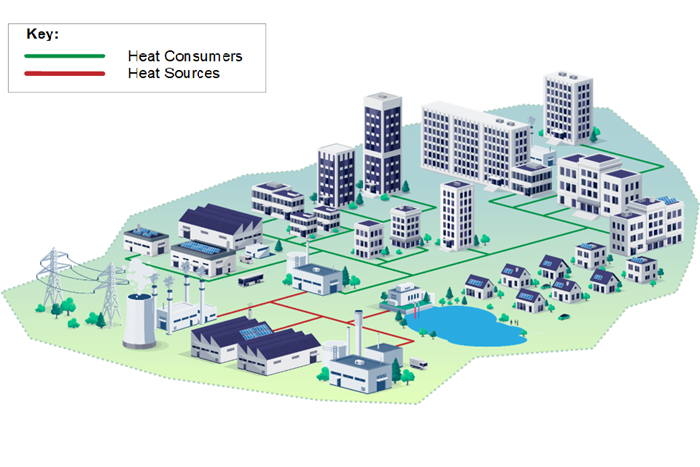
What is a heat network?
A heat network, also known as a district heating system, is a centralised energy distribution system that provides heating and, in some cases (considering the UK’s recently hot summers), cooling to multiple buildings or residential units from a common source. It involves the transport of hot water or steam through a network of pipes to deliver heat. Heat networks are not a new technology and there are many heat networks within the UK right now. However, a renewed focus following their mention in the Energy Act means that now’s a great time to brush up on the role that heat networks play in the UK’s energy transition.
Heat network zoning
Heat network zoning is a strategic approach aimed at optimising the deployment of heat networks in the UK by requiring particular buildings to connect to heat networks within their local zone. The goal is to ensure a smooth and efficient transition to low-cost, low-carbon heat; benefitting consumers, businesses, and the environment while addressing challenges faced by local authorities and investors.
The 2023 Energy Act, the largest piece of energy legislation in over a generation, provides the powers for government to implement heat network zoning in England through regulations. The recent consultation on heat network zoning has provided an increased focus on an area of the energy transition which has, up to now, had a fairly low profile.

Source: GOV.UK
Who will identify the heat zones?
Heat network zoning can be likened to a tree, where the roots represent the heat sources, and the branches symbolise the consumers. Just as the roots efficiently gather nutrients and water from the soil, heat network zoning strategically organises and allocates heat resources to different areas or "zones."
There are two zoning bodies involved: the Central Authority at the national level, and Zone Coordinators at the local level. The Central Authority, a division within the Department for Energy, coordinates the overall rollout, standardises market processes, and acts as a backstop for stakeholders. Zone Coordinators work locally, engaging with communities, choosing network developers, and coordinating the process.
The Central Authority acts as the main trunk, providing guidance and support analogous to the core of the tree. The Zone Coordinators (who will most likely be the local authority in an area), like skilled gardeners, work locally to nurture the growth of heat networks, understanding the unique needs and challenges of each zone, represented by various branches.
Where will the first heat network zones be?
The recent consultation applies to consumers in England, with Scotland producing their own regulation on the matter. The zones will be identified through a national mapping exercise, considering factors like building energy use, types, and local conditions.
When will heat network zones roll out in England?
Don’t panic – you don’t need to do anything yet; but it’s a great time for everyone to prepare. The implementation of heat network zones is set to begin in 2025. The current stage involves consultation, preparing for the rollout, making sure it's built into plans, and familiarising stakeholders with the upcoming changes.
Why is heat network zoning important for energy transition?
Heat network zoning is essential for the UK's energy transition, as it aims to decarbonise heating in buildings and contribute to the net zero target. The Climate Change Committee has estimated that around 20% of UK heat could come from heat networks by 2050. Currently this is only about 3% of where the UK’s heat comes from, showing a big area of growth. It addresses challenges, such as increasing the capacity of, or building the new infrastructure needed to operate heat networks, provides clarity on roles and responsibilities, and encourages the use of low-cost, low-carbon heating options. The initiative aims to make the process smoother for organisations and stakeholders, with benefits including cheaper and greener heat, exciting opportunities for supply chains, certainty for investors, and potential for local job creation.
What do investors think about energy from heat?
In our recent energy transition outlook report, only 4% of respondents said they found the growth and investment opportunities of renewable heat appealing – the lowest of all energy resources – but why?
When it comes to low carbon systems and energy it seems like everyone can grasp solar and offshore wind – but renewable heat systems just aren't getting the same amount of traction. However, when we think back to the trajectory of offshore wind, we know that a relatively low-profile technology can turn into a success story – if it’s given the support and investment it needs.
If we want to get more private investors and executives on board with heat networks, we need a game plan; we need to increase the level of certainty to make heat networks look like a good bargain. It's not just about throwing money at it (although that helps). We need people to want to connect into the heat network once its created. The government has worked for several years to create a self-sustaining heat networks market and zoning will only make that market stronger. Certain buildings will be made to connect into the heat network increasing the need for more heat networks and certainty of investment.
Finally, we need to raise the PR game of heat networks – let's shout from the rooftops about the environmental perks and growth opportunities. Mix in some scalability magic, and suddenly, we've got a more appealing package. It’s time for heat networks to shine.



